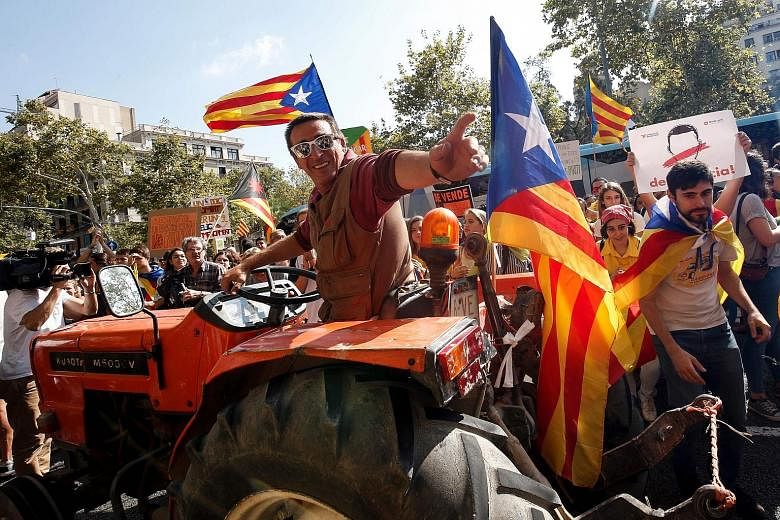VIC (Catalonia) • Rolling his rickety red tractor through a rural valley in Catalonia, Mr Jordi Colom seemed like just another farmer heading to the fields.
Except that he was in a lumbering tractor convoy. And cars honked in approval. People on the side of the road waved red-and-orange Catalan flags and cheered. They knew the role played by the "tractorada", loosely a tractor armada, in Catalonia's continuing independence movement.
In a region that draws part of its identity from the toughness of farmers, their tractors are now among the symbols of Catalans' fight for independence.
In recent months, farmers have lent their strength to marches, riding slowly with the demonstrators. During the contentious referendum on independence, the tractors were parked outside polling stations as a line of defence against intervention by the Spanish police.
Last week, Mr Colom and other farmers took part in a general strike across the region, and the tractorada lent its mechanised mass in support of independence and to denounce the police violence that had followed the vote.
"The politicians needed us to come out, like when we help fight wildfires, because we know the ground the best," said another farmer, Mr Martin Serralonga.
Mr Colom's family owns one of the hundreds of farms scattered across the valley, whose centre is the town of Vic. It is a major crossroads for two of the highways that cross Catalonia and bring the goods produced by the region to the rest of Spain and to France.
There was no struggle to get on the highway. Earlier, the police had cordoned off a portion of the road, and they gently waved the tractors on. Crowds stood on both sides, chanting and singing to the sound of grallas, a type of flute that sounds like a bagpipe and is a popular instrument in the region.
Once the tractors halted at the highway intersection, a huge traffic jam of trucks ensued. Unable to deliver their goods, a few of the drivers napped in their trucks.
The centre of the Catalan independence movement is Barcelona, a cosmopolitan metropolis, where urbanites are at the core of the demonstrations - which is why the tractors are a seemingly unlikely symbol.
Some tractors cost more than €100,000 (S$160,000) and feature computers, joysticks, control panels with LED lights and air-conditioned cabins. Others are second-hand clunkers. Farmers in the rest of Spain and Europe have for decades used tractors in protests about the cost of petrol or the wholesale price of produce.
But they have rarely attracted as much attention and popular support as they have in recent weeks.
For all their symbolic force, the farmers themselves seemed uncertain about what independence would bring, or if it was even likely to happen as soon as regional politicians predicted.
They preferred to talk about their ancestors' struggle, referred to in the Catalan anthem that crowds have been singing across the region.
Els Segadors speaks of a 17th-century revolt by peasants and others against Spanish rule. "Like in the anthem, we will break the chains with the sickles," said Mr Colom's brother, Miquel.
NYTIMES

